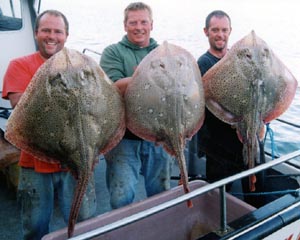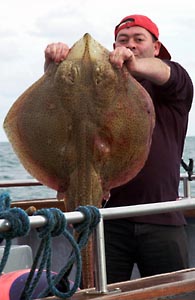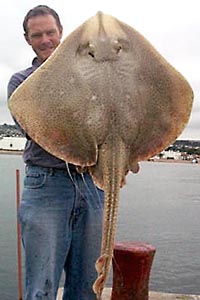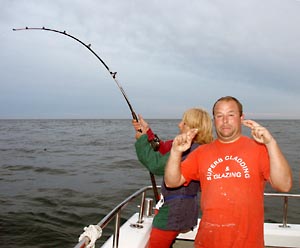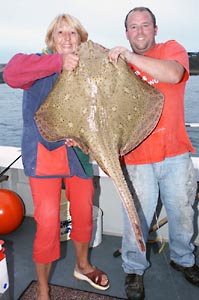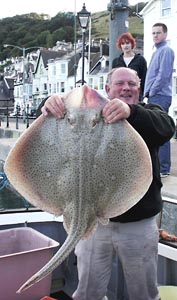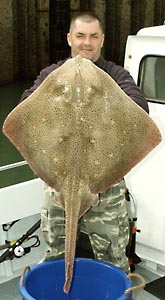 |
|||||||||||||||||
HOW TO CATCH DARTMOUTH BLONDE RAY |
|||||||||||||||||
Tell your Wife or Girlfriend you’re going out to pull a big “Blonde” and if you’re a regular sea angler, the chances are that she will already know only too well what your intended quarry will be. If not, stand by for fireworks or learn to explain yourself more explicitly. The magnificent Blonde Ray, (Oh dear, I’m sounding like Rex Hunt again), is a popular late season target species for boat anglers off Dartmouth. These fish have spent all summer feeding greedily on the sandeel which shoal on the edges of the offshore shingle banks such as the Skerries, as the result of which they have piled on weight and make a worthy adversary. I have often wondered how a big Ray can catch the small swift Launce, which is just a larger variety of sand eel? They do. Their stomach contents prove that they live on a rich diet of Launce, Crab and small fish. Location Blonde Ray prefer to live in water near the edge of sand or shingle banks at a depth of between 27 and 30 metres. They can be found at other depths, but they are most often encountered here. They move up and down the slope of the banks with the tide and seem to feed most readily in our local waters, when a particularly big spring tide is ebbing, running towards the west.
A reliable electronic depth finder allied to GPS, preferably with a clear chart plotter makes the task of finding and returning in your boat to the correct spots a far easier proposition. Tackle What tackle will you need to catch them? Clearly, you will be fishing from a boat and although the occasional Ray can be taken from a drifting boat, they are most often caught while at anchor from a suitable mark. Rod Your rod should be in the 30 to 50 lb class; the sort of rod you might use for Conger Eel. You will need to exert powerful leverage to get your specimen away from the bottom. They often hang against big tidal flows, using their wide flat body to exert the maximum strain on your tackle. Reel A good quality multiplier reel is the preferred choice to match your rod. It should preferably have a low gear ratio as the slog of pumping up a big fish in the 20 to 30 lb class, together with the lead weight which can be as much as 3 lbs and necessary to nail your bait to the sea bed can strip the gears on lesser models. Line 40 or 50 lb b.s. monofilament line is suitable, although I prefer a braid line as it is far thinner for a given breaking strain and consequently offers less resistance to a powerful tidal flow, facilitating the use of correspondingly lighter lead weights in deep water. The lack of stretch in braid line enables an angler to better feel the bite and to firmly set a hook at distance, but it does demand the shock absorption of a softer rod and a properly set clutch on your reel if you are to minimise breakages. Terminal Rig I like to attach a length of mono to the end of my braid as it absorbs abrasion and is easily replaced at insignificant cost. It also provides a limited cushioning effect, dictated by its length. Between 6 and 10 turns of mono on the reel is about right. You will need to learn to tie a “double grinner” knot to reliably attach your mono to the braid main line. These big fish will savagely test your knots and thoroughly exploit any weaknesses. Pass the line and leader through the eyes of your rod. Now thread a large bead onto your line so it will prevent the boom or swivel being pulled into the top eye, where it can jam and damage the lining of the tip ring. Next, thread your line through either a boom, or a running lead link. Place another smaller bead on your line below this to protect the knot, (yes it’s another “double grinner” you are about to tie), where you attach the end of your line to a heavy duty swivel, which must be able to freely counter the tendency for a large bait to rotate in the tidal flow. To the other end of this swivel you should use a “double grinner” knot to attach your hook trace, which should be at least 60 lb b.s. mono. I have lost fish while using 30 lb b.s. hook trace material. Ray have powerful jaws with grinding rasping pads in place of teeth, capable of quickly wearing their way through thinner trace material. If you are using a long trace of perhaps 20 feet, which is preferable when there is sufficient tidal flow to stream it out, you should prevent twist by inserting another heavy swivel in the centre of this length. A shorter trace is more practical when the tide is running gently, as a very long trace will twist and tangle in such conditions. The terminal tackle is completed by a good quality hook, somewhere between a size 3/0 to 6/0 tied on the end. Be certain your chosen hook is a strong pattern such as an O’Shaughnessy. The heavy Mustad bronzed hooks are fine. My preference is for the Japanese manufactured “Owner” brand, model 5111 SSWCP cutting point sea hook, or the newly introduced “Aki” model 5170 which are distributed in the U.K. by Harrison Advanced Rods of Liverpool, (‘phone 0151 709 5981). I quite often use “Circle” pattern hooks such as the “Owner” patterns distributed by Harrison Advanced Rods, or the “Eagle Claw” range supplied by The Harris Angling Co. (‘phone 08707 444970). These have the added advantage of ensuring that many more fish are lip hooked. Bait “Blondies” prefer fish baits. A fillet cut from the whole side of a freshly caught Mackerel is ideal. If you cut away and discard the silvery skinned stomach area of the fillet to leave a long narrow chunk, it will tend to reduce its tendency to spin in the tide. The hook should be inserted through the narrow tail end of the fillet just once, passing from the inner fleshy side and exiting through the skin where it must remain exposed to ensure ready penetration.
Paul McAdam, one of our more successful local anglers, prefers his Mackerel fillets to have been quickly frozen from fresh and then thawed. He told me he believes the big Ray seem to like the slightly softer texture. I guess the ice crystals rupture the cell walls in the freezing process and release more essential omega oils as they thaw. I have also used fresh “Greater Launce”, as a “flapper” bait with the backbone removed, yielding quite a degree of success. Various baits work on different occasions. Be prepared to experiment and try them all, until you find out which is best on that day. Technique This can be a waiting game. You let your bait down to the sea bed and check by lifting your rod tip repeatedly to ensure your weight is holding bottom. You will probably need to let out more line until you are certain. If your weight is lifting off the bottom, you will not catch theses big bottom dwelling Ray. You can often set the ratchet on your reel to provide an audible indication of a bite on an unattended rod. Next, be prepared for Lesser Spotted Dogfish to repeatedly steal your bait. You will soon learn to discern their rattling bite. You may need to replace your bait quite often if these become a problem. You just have to fish on through this distraction. I have utilised “Rubby Dubby” ground bait of mashed up fish pieces, let down in a weighted net sack, to attract Ray. It can be a great asset, although it sometimes attracts an excess of L.S.D. in the process. You will spot the bite of a Ray quite readily. Often the first indication is a gentle pulling on your rod tip as the fish settles on your bait. Be patient, sometimes what you are seeing is the Ray settling its whole body onto your bait (and line), to prevent it getting away. Next you will see several nods of the rod tip as the Ray shuffles to get its mouth over your offering. Strike too soon and you will either scare off the fish or foul hook it in its wings. Either leave the bite until you judge the fish has taken sufficient time to get your bait into its mouth, (this may take several minutes), or look for other signs such as the Ray moving off and taking line as it does so.
Now is the moment when you are ready to set your hook. If you are using a conventional hook, strike quite hard to drive it home. If you are utilising a “Circle” pattern, take up the slack in your line and lift gently into the fish. As you do so, the Ray will realise the bait is attached to something and turn away to one side as it makes off. It is then the “Circle” hook will penetrate its jaw, usually near the scissors to one side of its mouth. Now exert pressure to get the Ray up from the sea bed. This is the stage at which you may break your line unless you are very careful. Once the Ray is up and moving, you must keep up a steady pressure, but don’t try to bully the fish. Steady strain will encourage the fish to swim gradually to the surface. Lift your rod tip, apply pressure and then wind down. Repeat this sequence until your fish breaks surface.
Sometimes a particularly large quarry will make off down tide. Often when bullied, a big Ray will roll itself into a ball and hang against the tide. One solution is to mark your anchor rope with a “Dan” buoy for later retrieval and drift in your boat, down tide with the fish, while pumping it to the surface. This method assists younger anglers and ladies, who may not otherwise possess the brute strength required to land fish in these circumstances. You can grasp a Ray by its wing to one side of the head and lift it aboard the boat, but be careful; it can inflict a nasty crushing bite if you get your finger in its mouth. Local sporting angler Jason Upham is also a professional Brixham trawlerman, who handles fish every day of his life, yet he accidentally allowed one of the Rays in the above photograph to bite his thumb, which required dressing and caused him considerable discomfort.
When handling any Ray, beware of the sharp spines in the shape of rose thorns which protrude particularly from its back and tail. They can inflict a painful injury on the careless angler.
You may prefer to use a very big landing net, or in some circumstances you may have to gaff the Ray through a wing to lift it aboard. A pair of strong cotton gardening gloves can help reduce the rasping effect of the sandpaper like skin on the ends of your fingers when handling big Ray. Skate wings are considered a great delicacy, although they are not to my palate. I prefer to carefully remove the hook using pliers. If the fish has taken the bait deep down, I suggest you cut the trace near the Ray’s lips – but once again be careful, they can extend their lips to snap at you. Provided the hook is not stainless steel, the Ray’s digestive juices will soon corrode it away, allowing the fish to expel it within a few days. I get the most satisfaction when I can just to weigh these lovely creatures and return them to fight again another day; they are worthy opponents deserving your respect.
|
